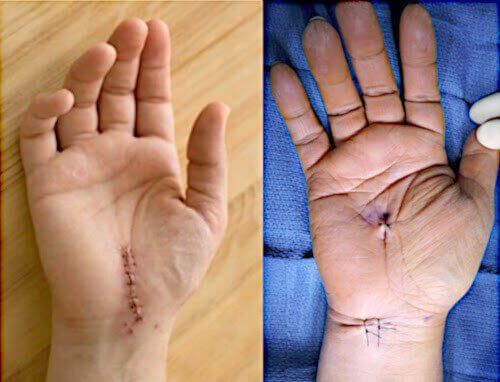Carpal Tunnel Surgery: 10 Pros and Cons You Should Know Before You Decide
By Dr. M. Zannakis | The CarpalRx
Carpal tunnel surgery can relieve severe pain and numbness, but it’s only successful for about 50% of patients. Learn the major pros and cons—including costs, recovery, and safer non-surgical alternatives like CarpalRx therapy.
Table of Contents
- Introduction
- Why there are pros and cons
- Pros of carpal tunnel surgery
1. Relief for severe cases
2. Around 50% success rate
3. Insurance coverage
4. Minimally invasive options
5. May prevent further nerve damage
- Cons of carpal tunnel surgery
6. Only 50% of patients are fully satisfied
7. High costs without insurance
8. Possible risks and complications
9. Long recovery and rehabilitation
10. Lost work time and job changes
- Four possible outcomes
- Before you decide
- Summary
- FAQs
- About
Introduction
If you’ve been living with numbness, tingling, or pain in your hands and fingers, you may be thinking about carpal tunnel surgery as a way to finally get relief. This procedure can help by releasing pressure on the median nerve, but it’s not without drawbacks—recovery can take months, and success rates vary from person to person.
Before making such an important decision, it’s crucial to weigh the pros and cons of carpal tunnel surgery, understand its risks, costs, and recovery process, and explore proven non-surgical options that may work just as well. This guide walks you through everything you need to know so you can make an informed, confident choice about your hand health.
🩺 Why there are pros & cons
If carpal tunnel surgery were painless, inexpensive, and guaranteed to work 100% of the time, everyone would choose it immediately.
But that’s not the case.
The
American Academy of Orthopedic Surgeons says the procedure can help many patients—but it also carries real risks, costs, and recovery challenges. Below are the
top 10 pros and cons of carpal tunnel surgery to help you decide if it’s right for you.
✅ Pros of carpal tunnel surgery
1. Relief for severe cases
For people with
advanced carpal tunnel syndrome who have exhausted other treatments, surgery can bring lasting relief by
releasing pressure on the median nerve. It’s often the last resort when symptoms severely affect quality of life.
2. Around 50% success rate
Surgical success is measured by patient satisfaction two years after the procedure. About
half of patients report being
satisfied
with their results. While that’s not perfect, for many people, even partial relief is worth it.
3. Insurance coverage
4. Minimally invasive options
The
endoscopic technique requires smaller incisions and may result in
less postoperative pain and a shorter recovery
compared to the traditional open surgery. Discuss which method fits your condition best.
5. May prevent further nerve damage
In severe or chronic cases, surgery can help
prevent permanent nerve damage by decompressing the median nerve before it deteriorates further.
⚠️
Cons of Carpal Tunnel Surgery
6. Only 50% of patients are fully satisfied
If half are satisfied, that means the other half aren’t. About 12% of patients
end up needing a second (“revision”) surgery, which often has lower success rates than the first.
The
cost of this surgery varies greatly. But without insurance, it ranges between $5,000 and $8,000. Hand rehabilitation can cost from $12,000 to $24,000.
7. High costs without insurance
Without insurance, the
procedure costs $5,000–$8,000, and rehabilitation can reach $12,000–$24,000. Complications can push expenses even higher.
8. Possible risks and complications
All surgery carries risks. Common complications include
nerve or blood vessel injury,
internal scarring,
infection, and
chronic pain. In some cases, mobility may be reduced due to tissue adhesions.
9. Long recovery and rehabilitation
10. Lost work time and job changes
Only about
10% of patients return to their original occupation after surgery. The rest must adjust duties or change jobs entirely. Recovery time before returning to work can range from
2 weeks to a full year, depending on your profession and hand dominance.
🔄
Four possible outcomes
After surgery, patients typically experience one of four outcomes:
- Total success – symptoms disappear permanently.
- Temporary relief
– symptoms return within weeks or months.
- No improvement
– symptoms remain the same.
- Worse symptoms
– increased pain, numbness, or weakness.
🧠
Before You Decide
Before committing to surgery, consider
non-surgical treatments proven to relieve carpal tunnel symptoms:
These options can often eliminate symptoms
without the cost, risk, or downtime of surgery.
Summary
Carpal tunnel surgery can be life-changing for some—but disappointing for others. The key is to carefully weigh the pros and cons, discuss non-surgical alternatives first, and consult a qualified hand specialist. Early treatment with safe, proven therapies like CarpalRx myofascial release may help you avoid surgery altogether—and finally say goodbye to numbness, tingling, and pain.
FAQs
1. How successful is carpal tunnel surgery?
Carpal tunnel surgery has about a
50% long-term satisfaction rate according to patient reports two years after the procedure. Some patients experience complete relief, while others notice partial improvement or symptom recurrence. Success depends on the severity of the condition and post-surgical rehabilitation.
2. What are the main risks of carpal tunnel surgery?
The most common risks include
infection, nerve injury, scarring, or prolonged pain. Some patients also experience stiffness or reduced mobility due to internal adhesions. Discuss these risks with your surgeon and always try non-surgical options first.
3. Are there alternatives to carpal tunnel surgery?
Yes. Most cases improve with
non-surgical treatments such as
night bracing, stretching, and myofascial release therapy—including home devices like the
CarpalRx. These options are FDA-cleared, safe, and often resolve symptoms without the risks or recovery time of surgery.
About






